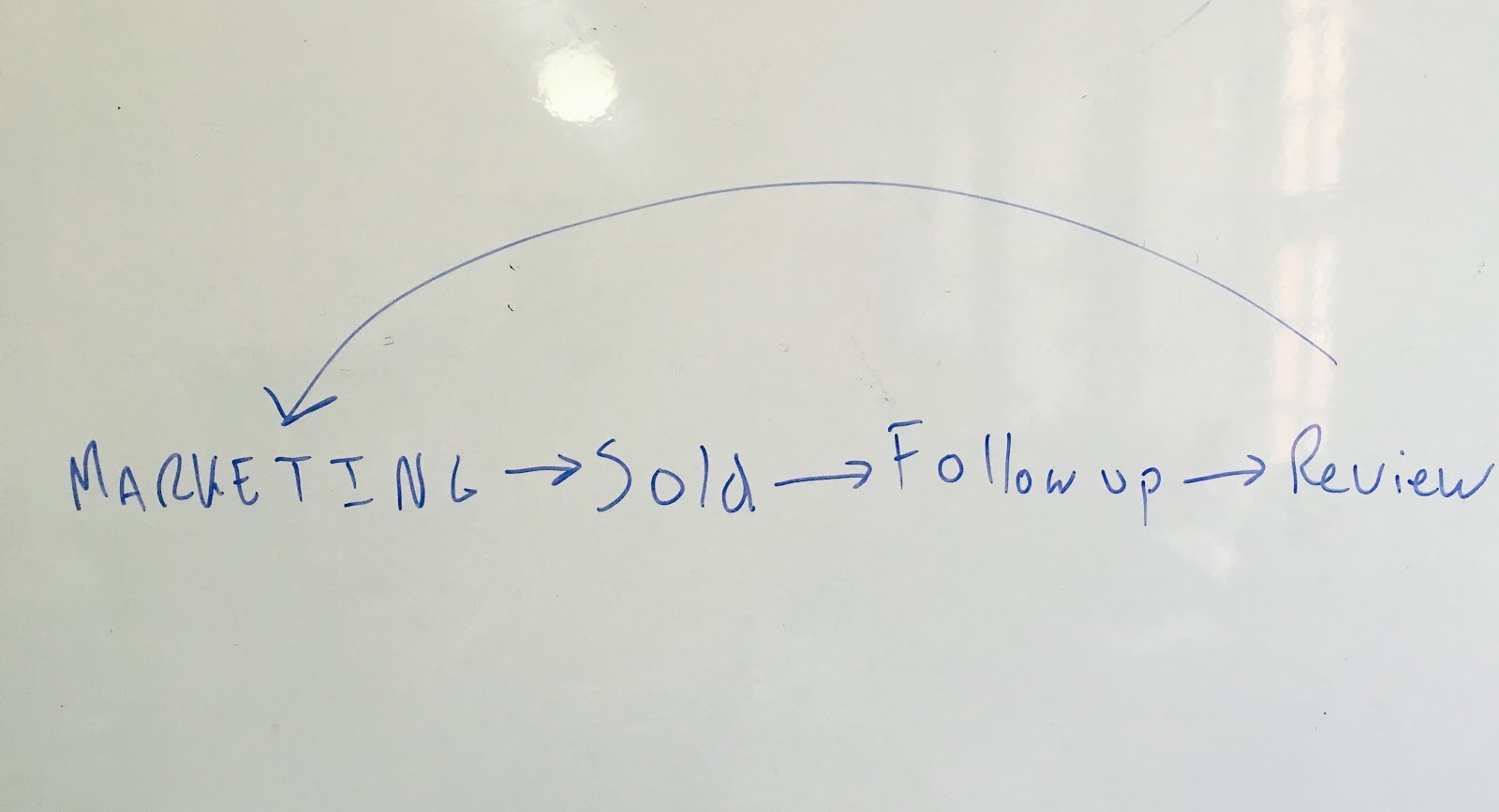The smartest thing I can say about growing a business right now is this:

It’s all about those four things. Nothing more.
The first two have been talked about a lot. You have to market your product, online and off, so more people learn about your company. Then you have to create the sale.
The latter two, follow-up and review, aren’t necessarily talked about as much. Of course, phrases such as “It’s easier to sell more to an old customer than getting a new one” and “The lifetime value of the customer is important” are common knowledge. Lately though, it has dawned on me that it’s more important than ever to:
- Create value for your customers.
- Harvest the value your product or service generates.
- Steer the harvested value toward an online reflection (i.e., a review).
Serendipity led me to discovery.
At my old company, Airtame, we developed a new product that didn’t live up to expectations. That led to a lot of feedback from agitated customers via email and on social media. A lot of it was deserved, and it motivated everybody in the company to put in more effort.
Six months later, results of our hard work began to show in the form of five-star reviews on Amazon, which became an increasingly important sales channel for us.
Customers can leave reviews everywhere.
Facebook, Uber, LinkedIn, Amazon, Airbnb, TripAdvisor, Apple’s App Store, Google Play, IMDb, YouTube—all of them are successful, and all of them have users creating and/or curating their content. It is smart, valuable and scalable, if done right.
Technology, and especially the internet, can make the whole world transparent—from intangible to tangible. Your company’s secrets and problems, good and bad, can find their way online in mere minutes.
Back in the day, a few bad interactions with customers may not have had a real impact because the message traveled slowly. In any case, management had a chance to train and correct the employee who made the mistake before the survival of the company was endangered. You don’t necessarily get that chance today.
On the flipside, if you are able to organize, nurture and harvest the great experiences being shared online, you may just become a winner in the review economy.
Getting customers to leave reviews is important.
There is money in gathering reviews. Why?
First, we as consumers regularly navigate society based on reviews. “Where should we eat in Barcelona, Spain?” Hmm… Let’s check TripAdvisor. “Which running shoe should I buy?” Let me check RunRepeat. “What movie should we watch tonight?” Let me check IMDb.
Second, all the platforms mentioned above are based on algorithms and code that work automatically with little to no human interference. Algorithms work off of myriad factors, including reviews, keywords and rates of sale. Each box you tick is another step forward for you in the eyes of the algorithm. If one person likes and buys your product—particularly if they give a good review—it becomes increasingly likely that more people will see it and choose to do the same.
We experienced this in our company. After we started prioritizing getting customers to leave reviews on our Amazon page, we saw 50% month-on-month growth. Reviews are gold. You have to deliver value and then reap the harvest.
How to get customers to leave reviews
You need a plan. There is no room for hoping and coincidences. Get familiar with things like automatic emails, net promoter score and personal touch.
Following the pressure of our failed product launch, we worked tirelessly to correct our errors and to make sure every single customer had a great experience with us. The result was a smooth follow-up process for everyone who bought our product.
The post-sale email campaign
We ensured this by applying a large degree of automation. When you bought an Airtame product, a larger process was initiated:
- An email was sent confirming the purchase and letting you know the order was on its way.
- The next day, we sent another email containing some tips on how to get started with your Airtame product.
- One week after completing the purchase, customers got an email from our onboarding manager, who asked if there was anything he could help with.
- If you replied to this email, it would go to our customer support team who could help make sure you got your Airtame product set up the right way.
- Thirty days later, we sent you a new email where we asked you on a scale from 1 to 10 how likely you were to recommend Airtame.
- If you rated us a 9 or 10, we asked you to review us on Amazon.
- If you rated us a 7 or 8, we considered each individual case before deciding how to proceed.
- If you rated us a 0 to 6, we began the process again to make sure you were happy with the product.
That’s how we did it. All the automated emails may sound a bit impersonal, but as soon as you made the move to reach out, one of us would handle your case individually. That person was not allowed to let you go before you are satisfied. Creating value for our customers was that important for us.
Create a relationship with customers.
Whatever your line of work, every email, conversation, haircut, serving, experience or interaction you have with your customer is a chance to make a new friend. Never forget this.
If you are confident that you always do a good job, you should consider asking your customers to leave a review on the platform of your choice. Start training your employees to (smoothly) ask for this.
You are only halfway done when you sell your product. You still have to measure the value you create for your customer and then direct it toward a positive online reflection. Creating value is key, and it is always where you should start.
This article was updated April 2023. Photo by GaudiLab/Shutterstock







